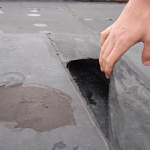How to Repair Old Felt Flat Roofs

Perished Felt Flat Roof
Unless expensive materials have been used the average life of a felted flat roof is about ten to l5 Years. Felted flat roof fails it is not worth trying to repair it and you should re-cover it. However, there are things you can do to repair minor faults and to extend its life before it needs to be replaced. Failure to act can result in water leaking through to the timbers below and causing rot.
Repairing Cracks and Blisters
You will need bituminous mastic (caulking) to repair a crack or blister in a felted flat roof. Although quite messy, the job is straightforward. First remove any loose chippings from around the damaged area with a brush- Using a hot-air gun, soften the felt first if necessary, and brush or scrape away dirt, moss and any other debris. With a crack or split in the roofing felt pull back the edges; with a blister make a cross-shaped pattern of cuts in the centre of the blister and peel back the four sections. It any seams are lifting, clean the area below them.
When the underlying surface has dried out-use a hot-air gun to speed this UP if necessary-apply mastic to the exposed area and press down the edges of the crack, blister or lifted seam, using something like a wallpaper seam roller. If a crack cannot be closed up, use polyester reinforcing tape or flashing strengthen the repair.
Some emergency roof repair compounds can be used to seal a leaking roof even if it is wet or under water. Instant repair aerosols can be used on damp roofs (and also on leaking flashing or guttering) ; check the manufacturer’s instructions. If a felted flat roof has several cracks and blisters, or is generally in bad condition it is possible to waterproof it with either a bituminous emulsion or a longer lasting elastomeric liquid rubber.
The whole roof should be swept clean before treating the surface which fungicide to kill any mould. Carry out any local repairs, then cover the surface with the emulsion or liquid rubber, tipping it out from the container and spreading it with soft brush or broom. Sponge away any splashes with solvent.
Some bituminous emulsions need a priming coat before the main coat all liquid rubber compounds are one-coat treatments and they last longer because they remain flexible, When the emulsion or liquid rubber coating has dried re apply stone chippings. Use new chippings. If the old ones are dirty or have lost their shine-the purpose of stone chippings on flat roofs is to keep them cool by reflecting sunlight.
Roof Junctions
The junction between a flat roof and the house wall is particularly prone to damage allowing water to seep through. The correct way to seal this joint is with lead flashing, inserted into one of the mortar courses of the wall, if a mortar fillet has been used to seal the junction, or if lead flashing has split the simplest way to affect a repair is by using a self-adhesive bituminous flashing tape.
Choose the appropriate type of tape to the task in hand. Clean the surfaces that are to be covered and apply any necessary primer before removing the backing paper and pressing down the flashing. Tape, first with your fingers, then a seam roller. Wear heavy-duty gloves when doing this as it can be messy. The tape can be cut with scissors required. Make good the mortar joints where any lead flashing meets the house wall, using fresh mortar.

 When you see this symbol you know you are dealing with a reputable roofing company
When you see this symbol you know you are dealing with a reputable roofing company